Solar eclipse of August 11, 1961
| Solar eclipse of August 11, 1961 | |
|---|---|
 Map | |
| Type of eclipse | |
| Nature | Annular |
| Gamma | -0.8859 |
| Magnitude | 0.9375 |
| Maximum eclipse | |
| Duration | 395 sec (6 m 35 s) |
| Coordinates | 45°48′S 4°00′E / 45.8°S 4°E |
| Max. width of band | 499 km (310 mi) |
| Times (UTC) | |
| Greatest eclipse | 10:46:47 |
| References | |
| Saros | 125 (51 of 73) |
| Catalog # (SE5000) | 9423 |
An annular solar eclipse occurred on August 11, 1961. A solar eclipse occurs when the Moon passes between Earth and the Sun, thereby totally or partly obscuring the image of the Sun for a viewer on Earth. An annular solar eclipse occurs when the Moon's apparent diameter is smaller than the Sun's, blocking most of the Sun's light and causing the Sun to look like an annulus (ring). An annular eclipse appears as a partial eclipse over a region of the Earth thousands of kilometres wide.
Related eclipses
Solar eclipses of 1961-1964
Each member in a semester series of solar eclipses repeats approximately every 177 days and 4 hours (a semester) at alternating nodes of the Moon's orbit.
| Solar eclipse series sets from 1961-1964 | ||||||
|---|---|---|---|---|---|---|
| Descending node | Ascending node | |||||
| Saros | Map | Saros | Map | |||
| 120 |  February 15, 1961 Total |
125 |  August 11, 1961 Annular | |||
| 130 |  February 5, 1962 Total |
135 |  July 31, 1962 Annular | |||
| 140 |  January 25, 1963 Annular |
145 |  July 20, 1963 Total | |||
| 150 |  January 14, 1964 Partial |
155 |  July 9, 1964 Partial | |||
| Partial solar eclipses of June 10, 1964 and December 4, 1964 belong in the next lunar year set. | ||||||
Metonic series
The metonic series repeats eclipses every 19 years (6939.69 days), lasting about 5 cycles. Eclipses occur in nearly the same calendar date. In addition the octon subseries repeats 1/5 of that or every 3.8 years (1387.94 days).
| 21 eclipse events between August 12, 1942 and August 11, 2018 | ||||
|---|---|---|---|---|
| August 10-12 | May 30 | March 18 | January 4-5 | October 23-24 |
| 115 | 117 | 119 | 121 | 123 |
 August 12, 1942 |
 May 30, 1946 |
 March 18, 1950 |
 January 5, 1954 |
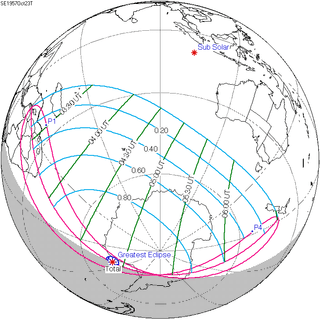 October 23, 1957 |
| 125 | 127 | 129 | 131 | 133 |
 August 11, 1961 |
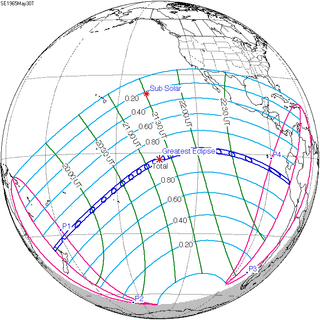 May 30, 1965 |
 March 18, 1969 |
 January 4, 1973 |
 October 23, 1976 |
| 135 | 137 | 139 | 141 | 143 |
 August 10, 1980 |
 May 30, 1984 |
 March 18, 1988 |
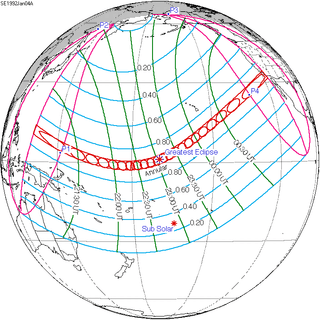 January 4, 1992 |
 October 24, 1995 |
| 145 | 147 | 149 | 151 | 153 |
 August 11, 1999 |
 May 31, 2003 |
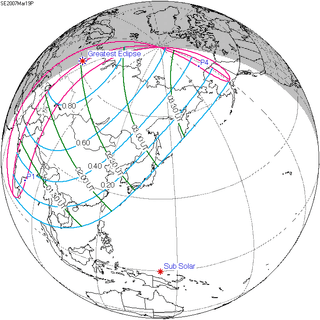 March 19, 2007 |
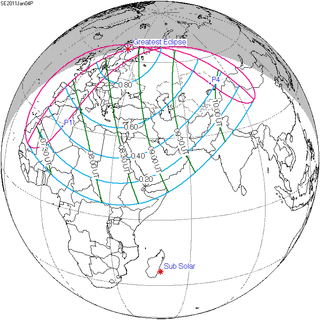 January 4, 2011 |
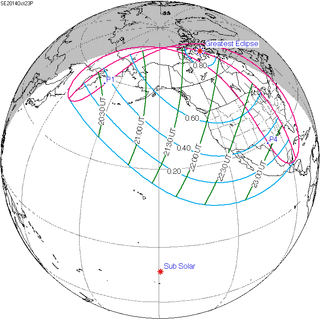 October 23, 2014 |
| 155 | ||||
 August 11, 2018 | ||||
Notes
References
- Earth visibility chart and eclipse statistics Eclipse Predictions by Fred Espenak, NASA/GSFC
| Wikimedia Commons has media related to Solar eclipse of 1961 August 11. |
